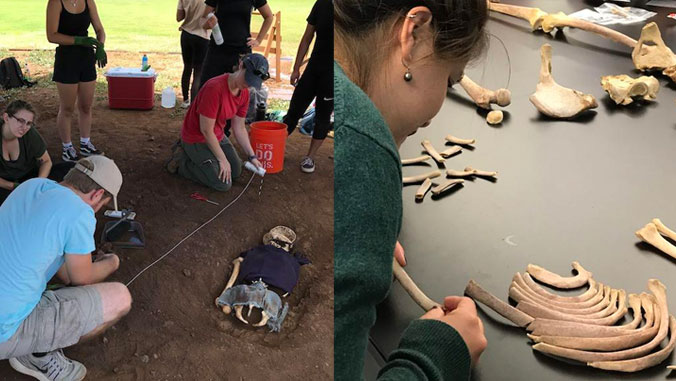
Kiana Miller had a puzzled look on her face as she stood with each hand stuck into one of holes on the side of a cardboard box in front of her. She couldn’t see inside the box. But emblazoned on it was the word “BONES,” and from where observers sat, they could see a drawing straight from the pages of a Halloween cartoon book, showing a family of skeletons sitting around a dinner table.
This may not be exactly what students expected who signed up for the Human Skeleton in Forensic Anthropology and Medicine course this summer at the University of Hawaiʻi. But it is part of why the innovative class won an academic award out of the starting gate and just completed its third year at UH, reaching more students that ever.
Recognized by the Western Association of Summer Session Administrators as the best summer course in 2017, this year’s class brought together 37 students from Hawaiʻi, Tennessee, Massachusetts, Florida, Montana, Washington state, Germany and Thailand, to learn in the anatomy labs of the John A. Burns School of Medicine (JABSOM) and in the field and classrooms at UH West Oʻahu.
The forensics course was the brainchild of Bob Mann, the JABSOM adjunct anatomy professor whose long resume includes service as the founding director and primary instructor of the Joint POW/MIA Accounting Command’s Forensic Science Academy from 2007 to 2014.
“The exercise provides participants with a hands-on experience that highlights the importance of using all of the senses when doing an examination, whether of a bone or a living patient,” said Mann.
Course faculty member Jennifer Byrnes, UH West Oʻahu assistant professor of forensic anthropology, described this summer’s students as diverse, including professionals who traveled from abroad to learn from the UH team.
“We had some participants who had no experience in archaeological methods to some that were professionals,” said Byrnes. “I think this leads to an atmosphere of knowledge sharing in small groups, in which all individuals took away something new after participating in the archaeological recovery day.”
See the full story on the JABSOM website.
—By Tina Shelton

